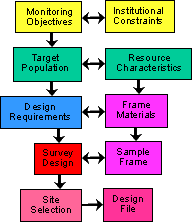Developing Design Structure - Objectives
 |
The Design Team has developed a process to guide the development of a survey design for Aquatic Resource Monitoring. The process includes several steps and feedback loops among the general components and information sources that lead to a survey design. Completion of the process is required before field implementation. An illustrative example of the design processes is presented based on the EMAP Western Pilot Program. See Indiana Streams for another example. |
| The Design Process starts with the designation of the Monitoring Objectives |  |
|
Western Pilot Objective for Streams and Rivers: Describe the current ecological condition of flowing waters of the West (conterminous States of EPA Regions 8, 9, 10). Specific Extent Objectives for the Study area, and each EPA Region and State are:
|
Estimate for each State, EPA Region and Study Region:
|
![[logo] US EPA](../gif/logo_epaseal.gif)